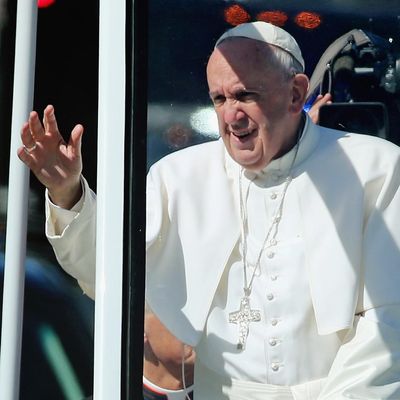
“I saw a news report last night on ‘Pope pizza,’” Becky Ianni, a 57-year-old woman with light-brown hair cropped in a bob, is saying. “We were in Barnes & Noble and it was plastered with stuff about the Pope. Everything was about the Pope.” It’s Monday afternoon, and Ianni and seven other people — most of them former Catholics, most of them sexual-assault survivors or their family members — are protesting outside the U.S. Conference of Catholic Bishops Headquarters in northeast Washington.
This is a rough week to be a Catholic Church protester. The American public’s interest in the Catholic Church right now seems to begin and end with Pope Francis — as a global celebrity, charismatic spiritual leader, and transformative political figure. Francis will make his debut before Congress this week as more than just a media darling: Only 3 percent of Catholics view him unfavorably, according to a recent Times poll. The view of the Pope is so favorable among Catholics here, according to another Pew survey from earlier this summer, that 55 percent of them rated him as doing an “excellent” or “good” job addressing the abuse scandal — a number that, when compared to his approval rating on other issues, was actually considered low. Meanwhile, the decades-old conversation about the church’s legacy of sexual abuse, which for a long time has been the dominant one around the institution, has quieted somewhat.
Francis made remarks to U.S. bishops about sexual abuse and is likely to meet with abuse survivors on this trip, as he has done in the past, but that’s far from enough for this group of abuse survivors, many of whom are pained by the huge celebration surrounding his arrival. “Last week, when we were getting ready for him to come, I started getting more and more anxious,” Ianni says. She and the others who say they were abused by priests don’t think Pope Francis has lived up to his responsibilities on the church’s legacy of abuse. In June, the Pope called for the creation of a Vatican tribunal to judge bishops who covered up the abuse scandal, but the bishops by and large still haven’t faced any consequences for their actions. The Pope has the authority to discipline them on his own, but hasn’t done so. Ianni was sexually victimized by a priest named William T. Reinecke when she was a child growing up in Virginia, but she wasn’t able to step forward with her story until 2006, she says. (Her claim was later ruled credible by her local diocesan review board.) She says she’s never been able to fully get over the betrayal she felt.
Barb Dorris, a grandmother who says she joined the group after discovering a priest in her parish molesting a child and church officials failed to oust him, pointed toward a news report last week showing that American priests accused of sexual assault were sent to Latin American countries to continue working in the church rather than being turned over to the authorities. She, too, wants the Pope to move on disciplining bishops as soon as possible. “I’m one old lady standing on a corner. This Pope has all the power. He could make the changes necessary,” she says.
“There’s so much hysteria about the Pope coming, and you know, he’s a likable guy,” says Judy Lorenz, another protester standing with Ianni. “When he came in on March 13, 2013, I was very moved when he put his head down and asked us all to pray for him.” But, Lorenz said, “Unfortunately he’s come out with the same things [to address the abuse crisis] — establishing a commission, this and that, but not really disciplining these bishops.”
Given the absolute saturation of pre-papal-visit coverage, you might think that the demonstration might get a fair amount of media attention. But you’d be wrong. The protesters mostly stand by themselves as cars whiz by. An hour and a half after their protest started, two young journalists — one holding a camera, the other a microphone — stop by for an interview. As the protest begins to break up, Dorris and the others express the hope that their message isn’t forgotten amid the spectacle of the week. But they’re worried it already has been.





























